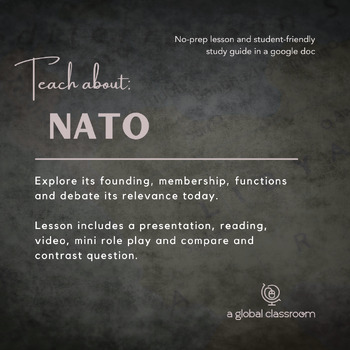Is NATO still relevant? IBDP Global Politics
A Global Classroom
11 Followers
Grade Levels
9th - 12th, Higher Education, Adult Education
Resource Type
Standards
CCSSRI.11-12.1
CCSSRI.11-12.10
CCSSCCRA.SL.1
CCSSRH.9-10.2
CCSSRH.11-12.1
Formats Included
- PDF
Pages
10 slides, 9 pages
A Global Classroom
11 Followers
Description
This lesson introduces students to NATO and engages them in a debate about its relevance today. The lesson includes:
- A quiz to see what students know about NATO
- A brief presentation which provides an overview of NATO and includes maps, visuals and a final video of an SNL skit of “world leaders in the cafeteria at the 2019 NATO summit who are caught making fun of Trump”
- A video, reading and comprehension questions
- A mini role play in which students take on the role of either Ian Bremmer or Stephen Wertheim and debate the question of whether or not NATO is still relevant today
- A compare and contrast question
- Additional readings and videos
Aligned with Common Core, C3 Framework for Social Studies and IBDP Global Politics
Total Pages
10 slides, 9 pages
Answer Key
N/A
Teaching Duration
2 hours
Report this resource to TPT
Reported resources will be reviewed by our team. Report this resource to let us know if this resource violates TPT’s content guidelines.
Standards
to see state-specific standards (only available in the US).
CCSSRI.11-12.1
Cite strong and thorough textual evidence to support analysis of what the text says explicitly as well as inferences drawn from the text, including determining where the text leaves matters uncertain.
CCSSRI.11-12.10
By the end of grade 11, read and comprehend literary nonfiction in the grades 11-CCR text complexity band proficiently, with scaffolding as needed at the high end of the range.By the end of grade 12, read and comprehend literary nonfiction at the high end of the grades 11-CCR text complexity band independently and proficiently.
CCSSCCRA.SL.1
Prepare for and participate effectively in a range of conversations and collaborations with diverse partners, building on others’ ideas and expressing their own clearly and persuasively.
CCSSRH.9-10.2
Determine the central ideas or information of a primary or secondary source; provide an accurate summary of how key events or ideas develop over the course of the text.
CCSSRH.11-12.1
Cite specific textual evidence to support analysis of primary and secondary sources, connecting insights gained from specific details to an understanding of the text as a whole.





